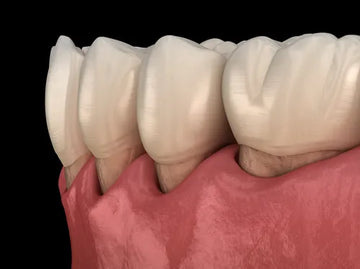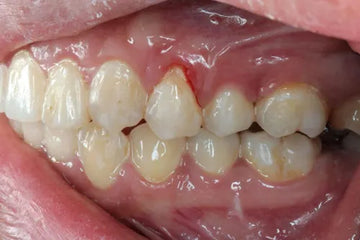Can Gum Recession Be Reversed?
If you’ve noticed your teeth looking longer, your gums feeling more sensitive, or your dentist mentioning “gum recession,” you’re probably asking the big question: Can gum recession be reversed?
The answer is nuanced. While some types of gum tissue loss are permanent, there is promising science — and results — showing that receding gums can be halted, improved, and in some cases, partially regenerated.
Let’s dive into how gum recession happens, what you can do to stop it, and how the right daily habits (and ingredients) can help your body restore gum health naturally.
What Is Gum Recession?
Gum recession occurs when the margin of the gum tissue surrounding the teeth wears away or pulls back, exposing more of the tooth or even its root. This creates gaps, or "pockets," where bacteria can accumulate, increasing the risk of decay and periodontal disease.
Causes of Gum Recession:
-
Aggressive brushing or using a hard-bristled toothbrush
-
Chronic inflammation from plaque and bacteria
-
Poor dental hygiene
-
Tobacco use
-
Hormonal changes (especially in women)
-
Grinding or clenching teeth
-
Genetics
Can Gum Recession Be Reversed?
Let’s break this down:
-
True regeneration of lost gum tissue is limited. Once gums have pulled back significantly, they don’t “grow back” in the way a cut on your skin does.
-
However, you can stop the progression, reduce inflammation, tighten gum pockets, and in some cases, achieve measurable tissue repair and reattachment. We have combined the best ingredients for specifically just that, in our toothpaste which can be found here.
So while complete reversal may not always be possible, partial regeneration and dramatic improvement are achievable — especially when addressed early with our toothpaste.
How to Stop and Reverse Receding Gums Naturally
1. Eliminate the Root Cause
Before healing can begin, you must stop what’s causing the damage:
-
Switch to a soft-bristle toothbrush and use gentle pressure
-
Avoid toothpastes with SLS, alcohol, or artificial ingredients that irritate tissue
-
Address underlying periodontal disease or inflammation
2. Use a Toothpaste Designed for Gum Healing
Most commercial toothpaste does nothing to support gum repair. Worse, many contain:
-
Glycerin, which coats teeth and can inhibit remineralization
-
Fluoride, which may suppress bacterial diversity
-
SLS (sodium lauryl sulfate), a known irritant
Instead, look for a periodontal toothpaste with ingredients that nourish and restore the gums.
TranscenDental Paste includes the follow for gum nourishment:
-
Hyaluronic Acid: Enhances soft tissue healing, reduces inflammation
-
Buffered Vitamin C (Calcium Ascorbate): Supports collagen formation and antioxidant defense
-
Vitamin E: Protects and moisturizes delicate tissues
-
Glutamine: Fuels epithelial cells and supports regeneration
-
Black Cumin Seed Oil: Fights microbial overgrowth
-
Methylated B Vitamins (B9, B12, Biotin): Nourish gum tissue at the cellular level
-
Gotu Kola, Yarrow, Ginseng, and Comfrey: Traditional botanicals for wound healing and tissue toning
-
Organic Birch Xylitol: Helps prevent plaque and balances the oral microbiome
Our TranscenDental Mouth Paste was designed exactly for this purpose: to support regeneration, reduce gum sensitivity, and reverse early signs of gum loss. It’s fluoride-free, glycerin-free, and 100% safe to swallow.
Clinical Studies on Gum Healing
Several studies support the use of natural ingredients in supporting gum health:
-
A study in the Journal of Clinical Periodontology showed that topical hyaluronic acid significantly reduced inflammation and bleeding in periodontitis patients (Source).
-
Xylitol has been shown to reduce plaque and improve gum health in multiple clinical trials (Source).
-
Comfrey and Gotu Kola are long used in traditional medicine and supported by emerging studies for epithelial regeneration and anti-inflammatory effects.
While gum graft surgery remains an option for severe cases, most mild to moderate recession responds well to proper oral care, targeted nutrition, and the right topical support.
Diet and Lifestyle Matter
You can’t out-brush a bad diet. Healing your gums requires reducing systemic inflammation and feeding your body what it needs to rebuild tissue:
Add These to Your Diet:
-
Pastured organ meats (rich in fat-soluble vitamins and minerals)
-
Bone broth (for collagen and glycine)
-
Raw dairy (calcium, phosphorus, fat-soluble vitamins)
-
Fermented foods (to enhance the oral and gut microbiome)
And don’t forget to hydrate. Dry gums are prone to inflammation and damage.
Final Thoughts: Can Gum Recession Be Reversed?
Yes — but it depends on how early you catch it and what you do next.
Gum tissue may not regenerate fully once lost, but with the right care:
-
Recession can be halted
-
Inflammation can be reduced
-
Attachment can be improved
-
And your gums can feel stronger, healthier, and more resilient
Take action now. Don’t wait for receding gums to become permanent.











